Abstract
Theiler's virus, a murine picornavirus, persists in the central nervous system of susceptible strains of mice, causing chronic inflammation and demyelination in the white matter of the spinal cord. Resistant strains, however, clear the virus and do not develop late disease. In this study, we compared the characteristics of T and B lymphocytes in C57BL/6 (resistant) and SJL/J (susceptible) mice 1 week after intracerebral infection. We detected a marked increase of the number of immunoglobulin M (IgM)-secreting cells in the spleens of C57BL/6 detected a marked increase of the number of immunoglobulin M (IgM)-secreting cells in the spleens of C57BL/6 mice (but not in those of SJL/J mice), which correlated with higher levels of serum IgM antiviral antibodies. The role of the humoral response in virus clearance and resistance was demonstrated by a marked decrease in the number of infected spinal cord cells in SJL/J mice after passive transfer of serum from infected C57BL/6 donors. The B-cell response was found to be partly T cell independent. These results suggest an important role of the early humoral immune response in resistance to Theiler's virus-induced disease.
Full text
PDF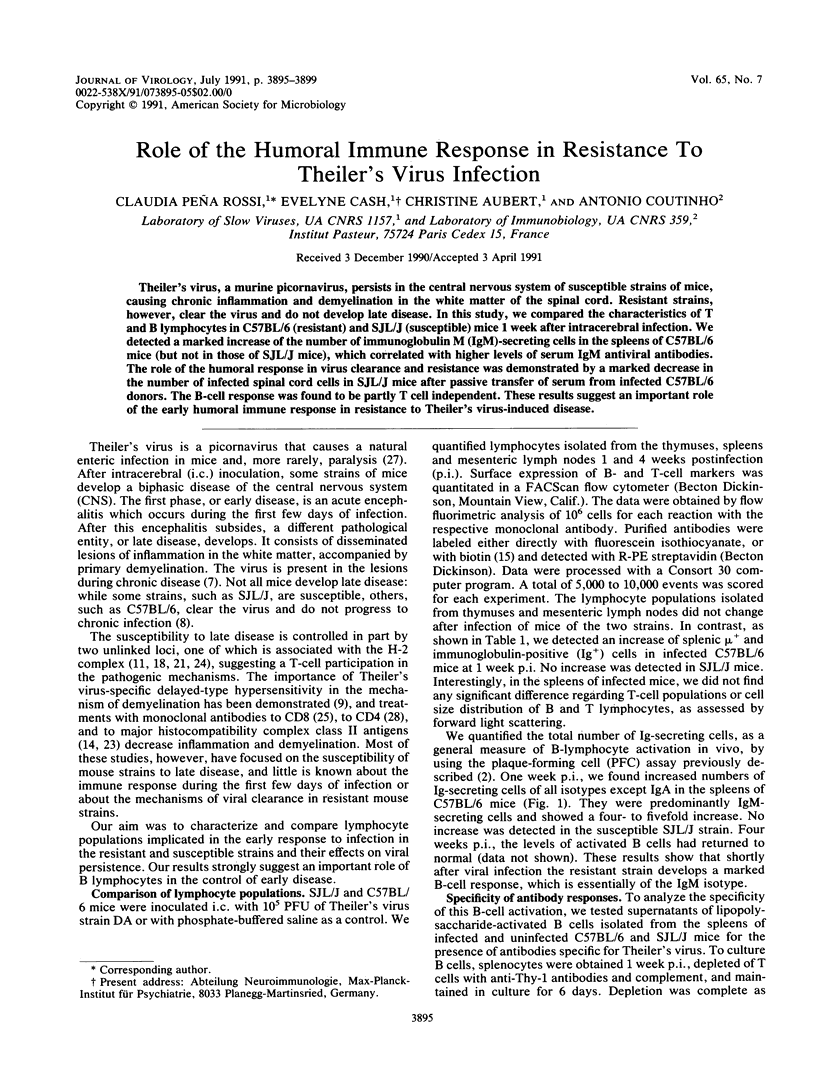
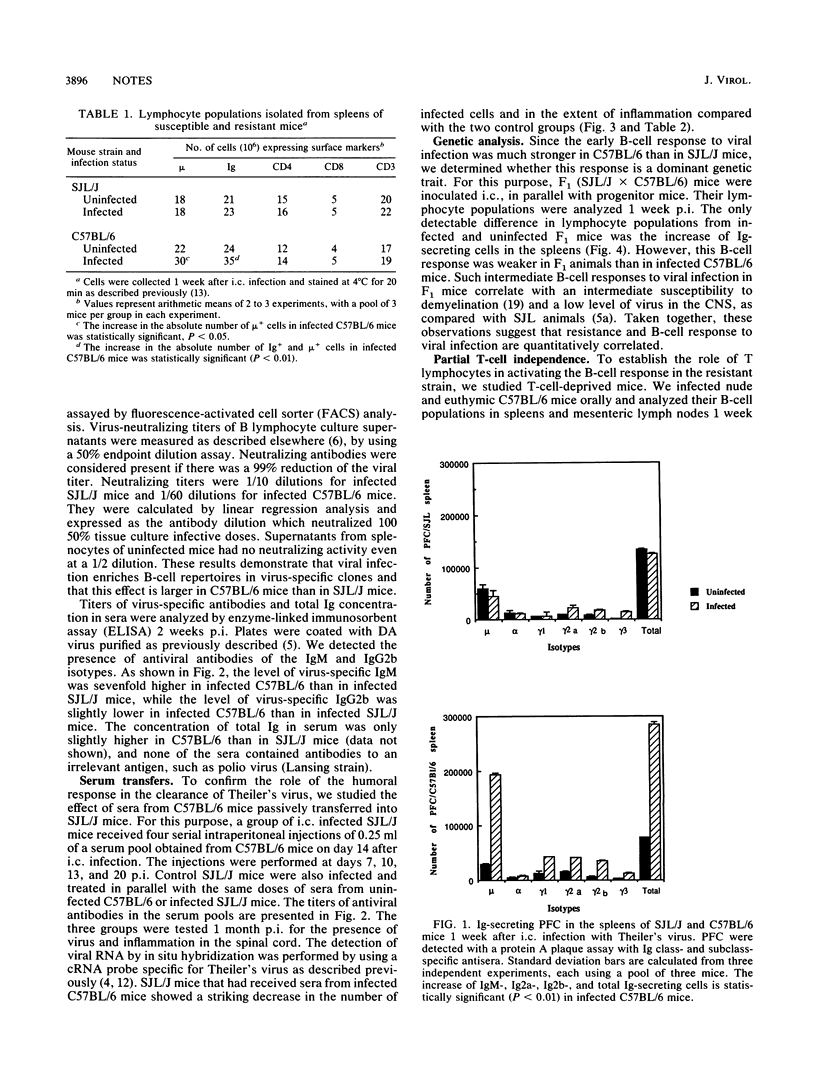
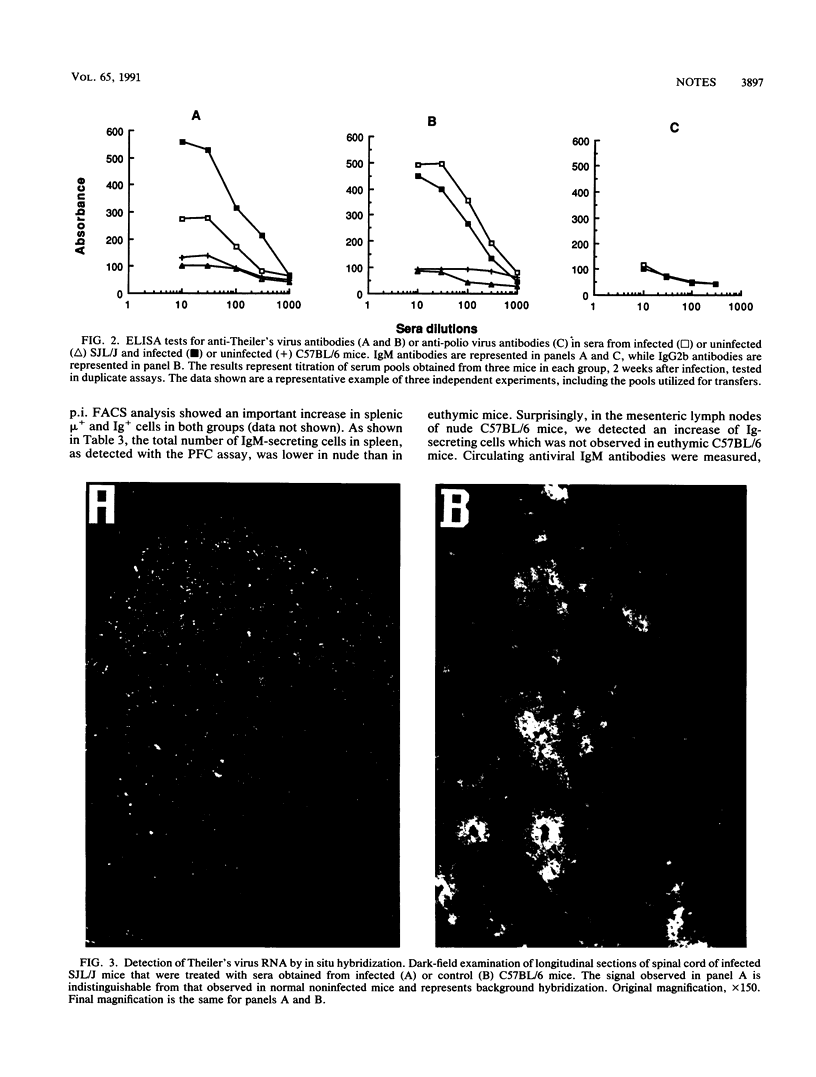
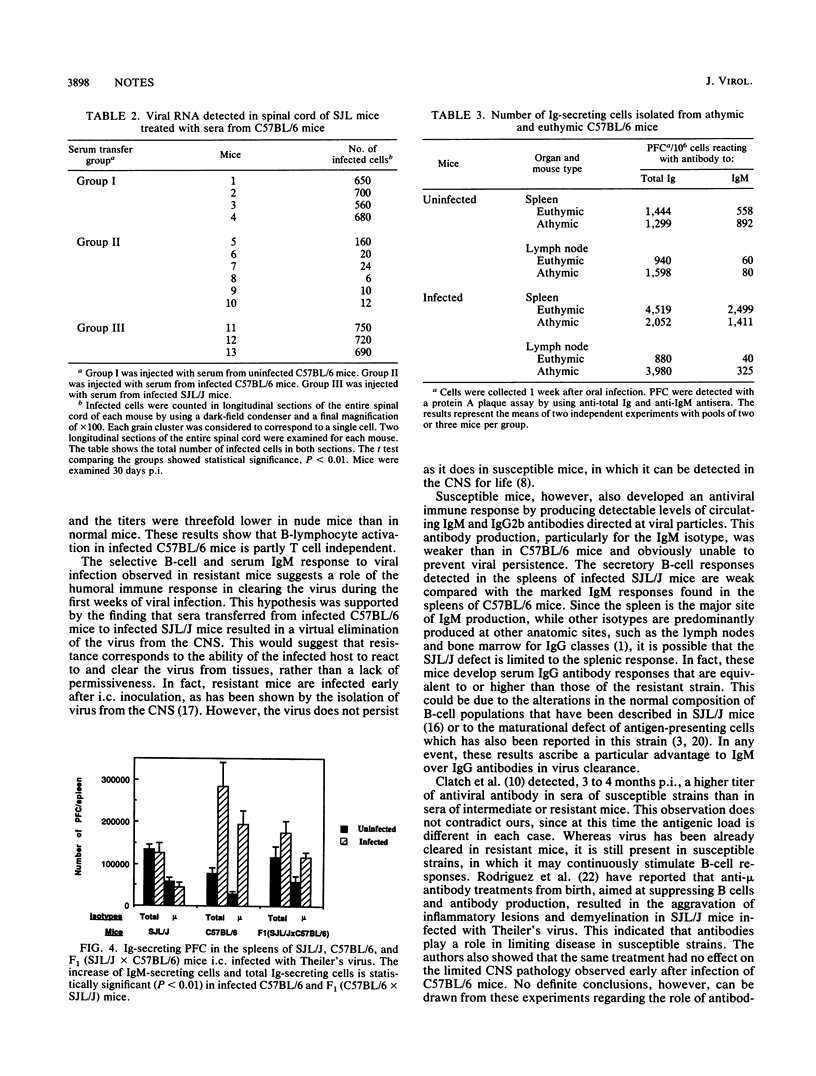
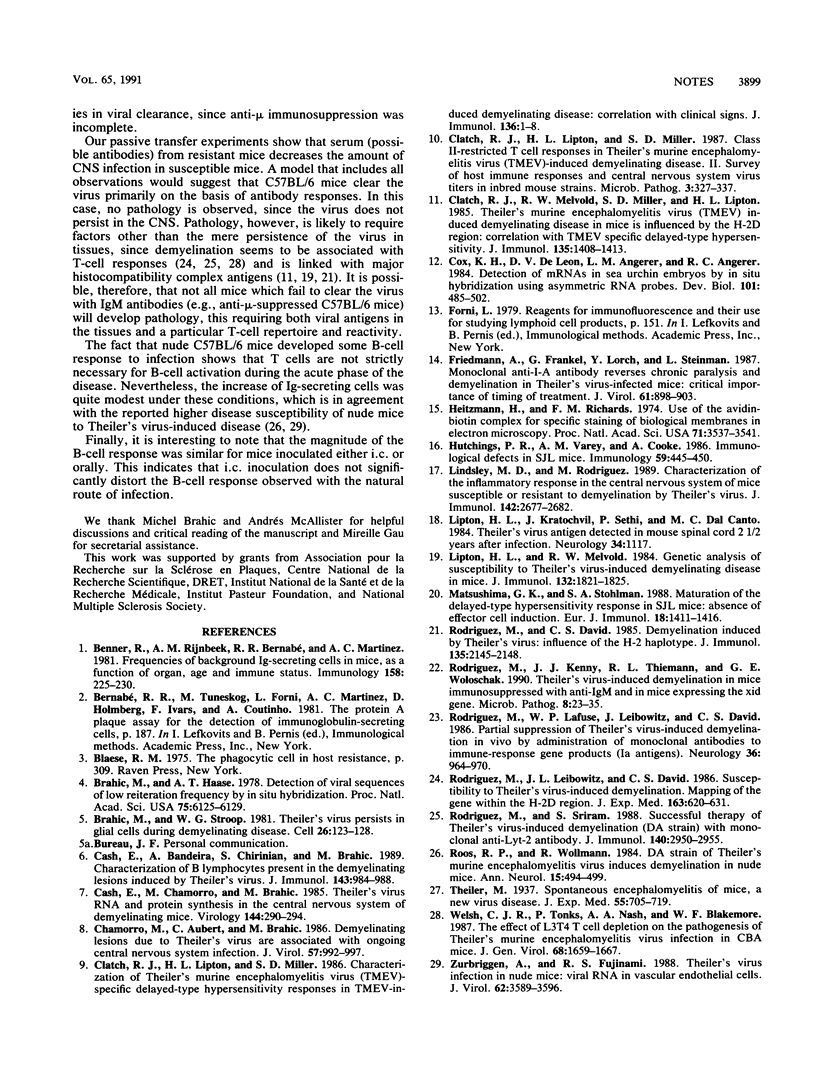
Images in this article
Selected References
These references are in PubMed. This may not be the complete list of references from this article.
- Benner R., Rijnbeek A. M., Bernabé R. R., Martinez-Alonso C., Coutinho A. Frequencies of background immunoglobulin-secreting cells in mice as a function if organ, age, and immune status. Immunobiology. 1981;158(3):225–238. doi: 10.1016/s0171-2985(81)80072-1. [DOI] [PubMed] [Google Scholar]
- Brahic M., Haase A. T. Detection of viral sequences of low reiteration frequency by in situ hybridization. Proc Natl Acad Sci U S A. 1978 Dec;75(12):6125–6129. doi: 10.1073/pnas.75.12.6125. [DOI] [PMC free article] [PubMed] [Google Scholar]
- Brahic M., Stroop W. G., Baringer J. R. Theiler's virus persists in glial cells during demyelinating disease. Cell. 1981 Oct;26(1 Pt 1):123–128. doi: 10.1016/0092-8674(81)90040-4. [DOI] [PubMed] [Google Scholar]
- Cash E., Bandeira A., Chirinian S., Brahic M. Characterization of B lymphocytes present in the demyelinating lesions induced by Theiler's virus. J Immunol. 1989 Aug 1;143(3):984–988. [PubMed] [Google Scholar]
- Cash E., Chamorro M., Brahic M. Theiler's virus RNA and protein synthesis in the central nervous system of demyelinating mice. Virology. 1985 Jul 15;144(1):290–294. doi: 10.1016/0042-6822(85)90327-7. [DOI] [PubMed] [Google Scholar]
- Chamorro M., Aubert C., Brahic M. Demyelinating lesions due to Theiler's virus are associated with ongoing central nervous system infection. J Virol. 1986 Mar;57(3):992–997. doi: 10.1128/jvi.57.3.992-997.1986. [DOI] [PMC free article] [PubMed] [Google Scholar]
- Clatch R. J., Lipton H. L., Miller S. D. Class II-restricted T cell responses in Theiler's murine encephalomyelitis virus (TMEV)-induced demyelinating disease. II. Survey of host immune responses and central nervous system virus titers in inbred mouse strains. Microb Pathog. 1987 Nov;3(5):327–337. doi: 10.1016/0882-4010(87)90003-9. [DOI] [PubMed] [Google Scholar]
- Clatch R. J., Melvold R. W., Miller S. D., Lipton H. L. Theiler's murine encephalomyelitis virus (TMEV)-induced demyelinating disease in mice is influenced by the H-2D region: correlation with TEMV-specific delayed-type hypersensitivity. J Immunol. 1985 Aug;135(2):1408–1414. [PubMed] [Google Scholar]
- Cox K. H., DeLeon D. V., Angerer L. M., Angerer R. C. Detection of mrnas in sea urchin embryos by in situ hybridization using asymmetric RNA probes. Dev Biol. 1984 Feb;101(2):485–502. doi: 10.1016/0012-1606(84)90162-3. [DOI] [PubMed] [Google Scholar]
- Friedmann A., Frankel G., Lorch Y., Steinman L. Monoclonal anti-I-A antibody reverses chronic paralysis and demyelination in Theiler's virus-infected mice: critical importance of timing of treatment. J Virol. 1987 Mar;61(3):898–903. doi: 10.1128/jvi.61.3.898-903.1987. [DOI] [PMC free article] [PubMed] [Google Scholar]
- Heitzmann H., Richards F. M. Use of the avidin-biotin complex for specific staining of biological membranes in electron microscopy. Proc Natl Acad Sci U S A. 1974 Sep;71(9):3537–3541. doi: 10.1073/pnas.71.9.3537. [DOI] [PMC free article] [PubMed] [Google Scholar]
- Hutchings P. R., Varey A. M., Cooke A. Immunological defects in SJL mice. Immunology. 1986 Nov;59(3):445–450. [PMC free article] [PubMed] [Google Scholar]
- Katz M. E., Tite J. P., Janeway C. A., Jr The immunobiology of T cell responses to Mls-locus-disparate stimulator cells. III. Helper and cytolytic functions of cloned, Mls-reactive T cell lines. J Immunol. 1986 Jan;136(1):1–5. [PubMed] [Google Scholar]
- Lindsley M. D., Rodriguez M. Characterization of the inflammatory response in the central nervous system of mice susceptible or resistant to demyelination by Theiler's virus. J Immunol. 1989 Apr 15;142(8):2677–2682. [PubMed] [Google Scholar]
- Lipton H. L., Kratochvil J., Sethi P., Dal Canto M. C. Theiler's virus antigen detected in mouse spinal cord 2 1/2 years after infection. Neurology. 1984 Aug;34(8):1117–1119. doi: 10.1212/wnl.34.8.1117. [DOI] [PubMed] [Google Scholar]
- Lipton H. L., Melvold R. Genetic analysis of susceptibility to Theiler's virus-induced demyelinating disease in mice. J Immunol. 1984 Apr;132(4):1821–1825. [PubMed] [Google Scholar]
- Matsushima G. K., Stohlman S. A. Maturation of the delayed-type hypersensitivity response in SJL mice: absence of effector cell induction. Eur J Immunol. 1988 Sep;18(9):1411–1416. doi: 10.1002/eji.1830180917. [DOI] [PubMed] [Google Scholar]
- Rodriguez M., David C. S. Demyelination induced by Theiler's virus: influence of the H-2 haplotype. J Immunol. 1985 Sep;135(3):2145–2148. [PubMed] [Google Scholar]
- Rodriguez M., Kenny J. J., Thiemann R. L., Woloschak G. E. Theiler's virus-induced demyelination in mice immunosuppressed with anti-IgM and in mice expressing the xid gene. Microb Pathog. 1990 Jan;8(1):23–35. doi: 10.1016/0882-4010(90)90005-b. [DOI] [PubMed] [Google Scholar]
- Rodriguez M., Lafuse W. P., Leibowitz J., David C. S. Partial suppression of Theiler's virus-induced demyelination in vivo by administration of monoclonal antibodies to immune-response gene products (Ia antigens). Neurology. 1986 Jul;36(7):964–970. doi: 10.1212/wnl.36.7.964. [DOI] [PubMed] [Google Scholar]
- Rodriguez M., Leibowitz J., David C. S. Susceptibility to Theiler's virus-induced demyelination. Mapping of the gene within the H-2D region. J Exp Med. 1986 Mar 1;163(3):620–631. doi: 10.1084/jem.163.3.620. [DOI] [PMC free article] [PubMed] [Google Scholar]
- Rodriguez M., Sriram S. Successful therapy of Theiler's virus-induced demyelination (DA strain) with monoclonal anti-Lyt-2 antibody. J Immunol. 1988 May 1;140(9):2950–2955. [PubMed] [Google Scholar]
- Roos R. P., Wollmann R. DA strain of Theiler's murine encephalomyelitis virus induces demyelination in nude mice. Ann Neurol. 1984 May;15(5):494–499. doi: 10.1002/ana.410150516. [DOI] [PubMed] [Google Scholar]
- Welsh C. J., Tonks P., Nash A. A., Blakemore W. F. The effect of L3T4 T cell depletion on the pathogenesis of Theiler's murine encephalomyelitis virus infection in CBA mice. J Gen Virol. 1987 Jun;68(Pt 6):1659–1667. doi: 10.1099/0022-1317-68-6-1659. [DOI] [PubMed] [Google Scholar]
- Zurbriggen A., Fujinami R. S. Theiler's virus infection in nude mice: viral RNA in vascular endothelial cells. J Virol. 1988 Oct;62(10):3589–3596. doi: 10.1128/jvi.62.10.3589-3596.1988. [DOI] [PMC free article] [PubMed] [Google Scholar]



